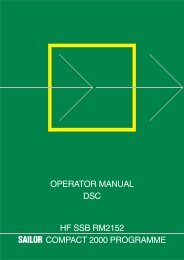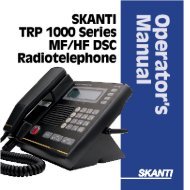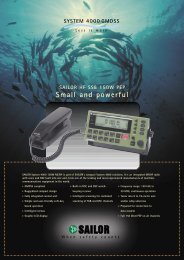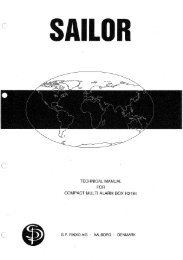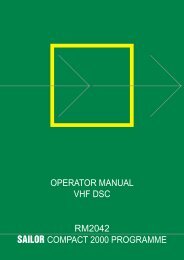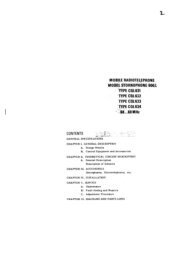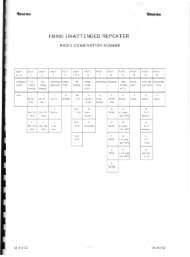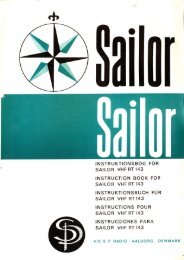TECHNICAL MANUAL FOR COMPACT VHF DSC RM2042
TECHNICAL MANUAL FOR COMPACT VHF DSC RM2042
TECHNICAL MANUAL FOR COMPACT VHF DSC RM2042
You also want an ePaper? Increase the reach of your titles
YUMPU automatically turns print PDFs into web optimized ePapers that Google loves.
5 CIRCUIT DESCRIPTION AND SCHEMATIC DIAGRAMS <strong>RM2042</strong>The crystal X3 is constructed to work at the 7th. overtone and is used in a series resonance mode.Unfortunately the crystal has also a parallel resonance frequency, which is located only 4 to 5 kHz abovethe wanted series resonance. This parallel resonance frequency is determined by the static capacitanceC oand is effecting the phase response of the crystal in an unwanted maner, which is lowering the trackingrange. To overcome this problem, the crystal is parallel connected with the inductor L9, which partly iseliminating the static capacitance.The oscillator is build-up around the bipolar NPN transistor Q5, which has a typical transition frequencyf tof 5 GHz. The transistor is used in a commen base configuration, where the capacitor C79 is used toground the signal at the base terminale.The oscillation is obtained by feeding back the collector signal to the emitter, where the crystal is usedas the feed back element. The adjustable coil L6 at the collector form a resonance circuit together withthe series connection of the capacitors C80, C81 and C82. The oscillation frequency can be adjusted bytuning the resonance freguency of this tank circuit, which will increase or decrease the phase shift in theopen loop response.The oscillator is followed by two buffers - an oscillator buffer and an LO buffer.To minimize the capacitive loading of the oscillator, the output signal is taped across a relative largecapacitor of 56pF. The taped signal is buffered by the transistor Q6, which is working as an emitterfollower.The output signal from Q6 is loaded with a resistor of 47 , which will camouflage the capacitive loadingby the input of the LO buffer and then stabilize the oscillator buffer at higher frequencies.In the LO buffer, the signal is amplified to give an output level of 7 dBm into 50 . The LO buffer is builduparound the transistor Q7, which is used in a commen emitter configuration. By means of the twocapacitors C89 and C90, the output impedance is matched to the mixer input of about 170 .CRYSTAL FILTER AND FIRST IF BUFFER AMPLIFIERThe receiver adjacent channel selectivity is obtained by means of the crystal filter FL1 at the 1st. IF andthe ceramic filter FL2 at the 2nd. IF.The input and output of the crystal filter is impedance matched to 3k, which is obtained by means of theresistors R13, R14, R15 and R16.From the 1st. mixer, the signal is led through the crystal filter to the input of the 2nd. IF buffer amplifier.This amplifier is build-up around the dual gate MOSFET transistor Q4, which has a tuned drain circuitconsisting of the inductor L5 and the capacitors C29 and C31.SECOND MIXER & LO, CERAMIC FILTER, FM-DETECTOR AND AF AMPLIFIERThe 2nd. mixer and LO, FM-detector and AF amplifier are all included in the integreted circuit U1, whichis of the type MC3372.From the 1st. IF buffer amplifier, the signal is led to the 2nd. mixer, where it is mixed with LO2.The second local oscillator frequency is crystal controlled and is tuned to 14.85 MHz by the trimmingcapacitor C34. The LO2 signal is generated by a build-in bipolar NPN transistor, which form a colpittsoscillator by means of the crystal X1 and four external capacitors.The output of the 2nd. mixer is led to the ceramic filter FL2, which is centered at 450 kHz. The 2nd. IFsignal is then amplified by the limiting IF amplifier, that approximately has a gain of 92 dB.The signal is detected by the build-in quadrature detector, which use an external capacitor and ceramicresonator as the 90° phase shift network.After detection, the signal is amplified by the build-in AF amplifier, and the carrier component at 450 kHzis removed by means of the resistor R38 and the capacitor C51. The output level from the following deemphasisfilter is adjusted by the trimming resistor R66 to 250 mV with an input carrier modulated with1 kHz to give a peak frequency deviation of 3 kHz.As an extra facillity, the MC3372 has a level meter output, which in this design only is used to adjust thefront-end filters. The level meter output is formed as a current generator, that produce a DC-currentproportional to the carrier level measured in dBm. The current is transformed to a voltage by means ofthe resistor R27 and is filtered by the capacitor C43.AF FILTERSThe output signal from the AF amplifier inside U1 is led through the MOSFET switch U6 to the deemphasisfilter, which is build-up around the operational amplifier U3.1. This filter is implemented as asecond order band pass filter with a center frequency at 950 Hz.PAGE 5-149341





